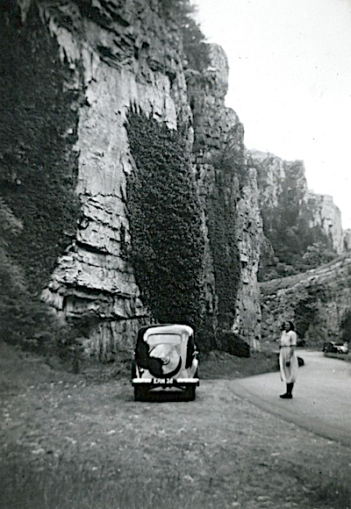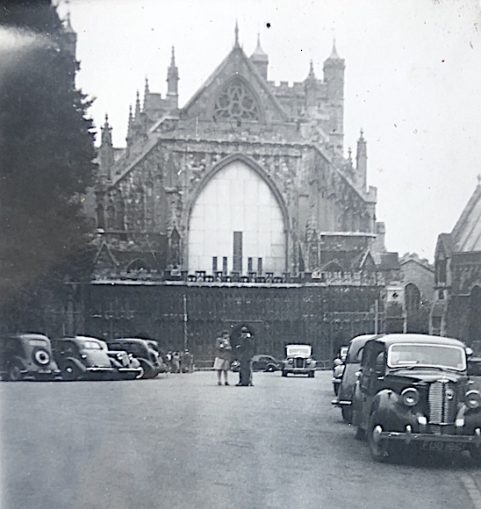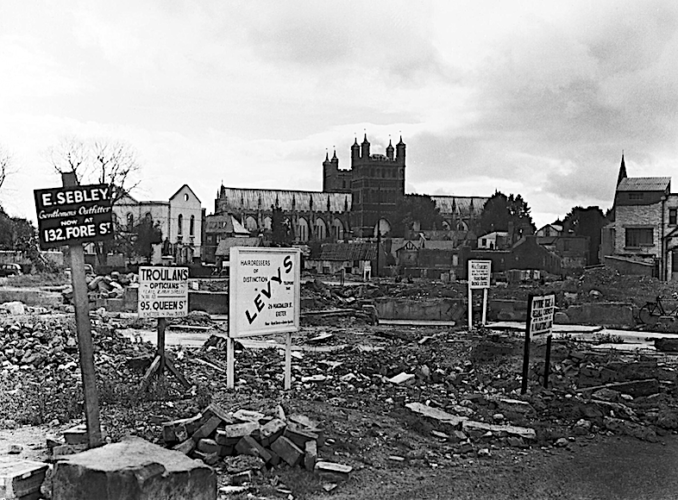1947
In 1947, England was recovering from the devastating impact of World War II, which ended two years prior. The country faced significant economic challenges, including a severe winter in 1947 that caused fuel shortages and disrupted transport. This led to rationing of essentials like food and clothing. Politically, the Labour Party, led by Prime Minister Clement Atlee, was in power and initiated major social reforms, including establishing the National Health Service. The year 1947 was also significant as it was when India and Pakistan gained independence from British rule, marking the beginning of the end of the British Empire.
In the summer before that harsh winter, my grandparents set off on their annual motoring holiday, this time to the West Country. En route they passed through Cheddar Gorge.

© Always Worth Saying 2023, Going Postal
Cheddar Gorge
Cheddar Gorge is a picturesque natural site located in the Mendip Hills, near the village of Cheddar, Somerset. Known for its limestone cliffs, England’s deepest natural canyon was formed by glacial meltwater during the last ice age. In 1947, the British Travel Association promoted it as a tourist destination through vintage travel posters, in an attempt to attract free-spending international visitors to the United Kingdom during those austerity years following World War II. One of these posters featured an image of Cheddar Gorge and was printed by Rembrandt Photogravure.
Despite the post-war period’s economic challenges, these posters encapsulated the charm of England’s natural beauty, providing a glimpse of tranquillity amidst the time’s uncertainties.
Cheddar Man?
Cheddar Man was a Mesolithic hunter-gatherer whose remains (Britain’s oldest near-complete human skeleton) were discovered in Gough’s Cave in Cheddar Gorge in 1903. Living approximately 10,000 years ago, he stood about 5’4” tall, had blue eyes, jet-black skin and girl-like long hair above a beardless face. Or did he?
Despite what a modern-day woke restoration claimed, a rudimentary look at the DNA evidence shows the flimsiest connection to black skin. Even the most basic research shows that Cheddar Man does not represent the earliest inhabitants of these islands. Other human remains found in the same caves are up to 4,000 years older. Nor is he an ancestor of modern Britons who only share 10% of his DNA.
Unconcerned with political correctness or today’s fake media need to challenge the common understanding of the appearance of the people of the past, my grandparents’ next photograph is grounded in the good old-fashioned certainty of bricks and mortar. And what interesting bricks and mortar they are.
Exeter
Exeter is a cathedral city and the county town of Devon. Situated on the River Exe and lying 60 miles along the A5 from Cheddar Gorge, it has a rich history. It was originally a centre for the Dumnonii tribe before being taken over by the Romans. The city played a key role during the Middle Ages and was the subject of multiple sieges.
Notable for its Norman cathedral, the Guildhall, and the University of Exeter, the city blends historical charm and modern ‘vibrancy’. The port of Exeter is accessible to small vessels and supports industries such as metalworking, leatherworking, and paper manufacturing.
Besides its historical significance, Exeter offers visitor attractions, including underground passages, guided tours, a Roman wall, and a quayside. Known as a foodie capital, it offers a diverse cultural scene, unique shops and boutiques, and hosts a variety of events and festivals. Its location also allows for outdoor activities and exploration of the surrounding countryside and the Jurassic Coast.
Exeter Cathedral
Exeter Cathedral, formally known as the Cathedral Church of Saint Peter in Exeter, is an Anglican cathedral and has been at the centre of ecclesiastical life in Devon for almost a millennium, serving as it does as the seat of the Bishop of Exeter. The establishment of the cathedral dates back to 1050 when founded by St Edward the Confessor. A fact that ties it closely with Westminster Abbey, as is both churches’ dedication to St Peter.
The cathedral is renowned for its architectural marvels, including an early set of misericords, an astronomical clock, and the world’s longest uninterrupted medieval stone vaulted ceiling. Despite suffering damages during the Dissolution of the Monasteries, the Civil War, and World War II, it has persistently undergone refurbishment and repairs to maintain its grandeur.

© Always Worth Saying 2023, Going Postal
The building to the far right is the medieval chancel of the Church of St Mary Major, which was demolished and rebuilt between 1864 and 1865. Unloved, it was demolished altogether in 1971. Before its removal, there had been a church of some form in that location for more than 1,300 years – over three centuries longer than the presence of the cathedral itself. In the modern day, we can stand in the exact spot where the old photo was taken, to the left of the Exeter war memorial and before the western frontage of the cathedral.
You can have a look around via this link. Puffins will note that the area hasn’t been rebuilt, but instead cleared and pedestrianised.

© Google Street View 2023, Google.com
Puffins will also note two features dominate the west frontage. Firstly, the west window, covered in 1947, which is one of the great architectural features of Medieval England. Secondly, an image screen containing large statues of kings, prophets and angels that sits below the window. Added as an afterthought (cathedral architect Thomas of Witney died c1342), the two lower tiers of sculptures date mainly from the mid-14th century. Everything above the main doorway largely dates to c1460-80. These are thought to have been the brainchild of Witney’s successor, William Joy.
In the old post-war photo, the west window isn’t covered for reasons of routine maintenance.
Exeter Blitz
The Exeter Blitz refers to a series of air raids conducted by the German Luftwaffe on the city during the Second World War. The first bombing happened on August 7 1940, after the RAF had bombed Germany’s historic Lubeck. German retaliation comprised of a “Baedeker Blitz” targeting cultural and historical towns rather than strategic or military sites.
The most devastating series of bombings on Exeter took place in April and May 1942 and significantly damaged the city’s infrastructure, including thousands of houses, shops, offices, warehouses, and pubs. Around 156 people were killed, and 583 were injured.
After the most serious raid, across the night of 3/4th May 1942, a Press Association correspondent telephoned a dispatch reporting that in some cases, only rubble and twisted steel denoted the site of shops, catering establishments and banks. A post office and a savings bank were destroyed. A hospital attached to an institution was also wrecked. The journalist labelled this a ‘typical Nazi Fury Raid.’
After midnight, 20 Luftwaffe bombers arrived over the town centre and, in 70 minutes, devastated the town centre and Newtown area. Over 10,000 incendiaries and 170 high explosive bombs were dropped on the Devon city.
Flares and incendiaries were followed by high-explosive bombs dropped by dive-bombing planes. Incendiaries were dropped by the thousand, and some of the bombs weighed up to two tons.
One fell on the Chapel of St James in the south choir aisle of the cathedral, causing considerable damage to the late 13th-century fabric. A contemporary newspaper report noted damage was chiefly confined to the south side, although almost every window was shattered. However, the famous east window had been removed 12 months previously, as had the Bishop’s throne. The main damage was to three bays of the south choir wall, immediately behind the position vacated by the throne. The bomb missed the great vaulted roof, but the blast effect on masonry and woodwork was considerable.
Although the organ was not disturbed, most pipes were displaced and twisted. The ancient cathedral clock, which tells the days of the month and the phases of the moon as well as the time, had registered the exact minute when the building was bombed. The clock stopped at seven and a half minutes past two. At that time four nearby beautiful oak screens of mid-15th century work were blown into a thousand pieces.

Shops that once stood on Exeter High Street,
MoI Photo Division – Public domain
At a morale-boosting public meeting, Exeter Chief Constable A E Rowsell paid tribute to the 28 fireguards ‘in the front line’ who had been killed. Despite the terrible risk to Exeter because of its narrow streets and antiquated shops and homes, the senior policeman was far from downbeat. There was a plan – more fireguards and fire watchers. Seventeen thousand had already been trained. More static water in buckets and baths within buildings to supplement the water tanks outside. Better coordination between business owners, fireguards, watchers, and civil defence authorities.
Fire watchers had saved many premises. Fifteen incendiary bombs had hit a cinema. However, an alerted fireguard party of three extinguished them all, and the building was still standing.
Rowsell spoke of the people who were on duty that night. They were ‘as keen as mustard.’ He was proud of them; they did an excellent job of work.
“The work of the fireguards requires courage,” he continued, “In the Exeter Blitz, 28 fireguards were killed, and they died in the front line of battle, and I say to you that from the lessons learned at Exeter, it is up to all of you to be fully prepared.”
One wonders what the brave and prepared people of Exeter would make of today’s black girlie Somerset gorge man and, come to think of it, what Chief Constable Rowsell might think of rainbow patrol cars and policemen in nail varnish.
© Always Worth Saying 2023


